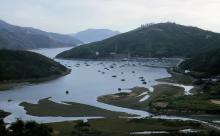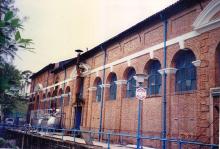Here's the AAB's Historic Building Appraisal. Unfortunately I didn't read it until after the visit, or I'd have looked for the loopholes and air raid shelter.
Historic Building Appraisal
Tai Tam Tuk Pumping Station
(Engine House, Chimney Shaft, Senior Staff Quarters & two Staff Quarters)
Tai Tam Reservoir Road, Tai Tam, Hong Kong
Historical Interest
Tai Tam Tuk Pumping Station (大潭篤抽水站) was first constructed in the First Section of the Tai Tam Tuk Scheme in 1908, including the engine house, store and office. It was extended during the Second Section in 1914-16 to accommodate additional pumping machinery. Further extension to the site was also made in 1925. The former senior staff quarters were built in 1908, and the staff quarters were built in 1919 and 1936. The chimney shaft was built in 1908.
Architectural Merit
The Engine House (機房) is a large single-storey warehouse type building with red-brick walls and Chinese tiled pitched roofs. There are
several annexes built on to it used as workshops, stores and offices. Architectural features include brick quoins at the corners, semi-circular arches and keystones to windows, pediments, column capitals and bull’s-eye windows. The annexes built at a later date have simple concrete lintels and cills. The windows are steel framed with small glazing squares. Loopholes formed in the wall facing the sea probably were for wartime defensive purposes. An underground air raid shelter is situated at the east end of the building. The architectural style has been classified as Neo-Georgian but it is better described as Georgian Revival.
The Chimney Shaft (豎井) is situated at the rear of the engine house. A smoke tunnel connected it to the engine house to take off the smoke generated by the coal burning steam engines that used to work the pumps. The chimney shaft is square in plan and built of red bricks with a plinth of offset courses and a coping of oversailing courses. It generally matches the engine house in style, but is classified in the Utilitarian category.
The Senior Staff Quarters (高級職員宿舍) are situated on a raised platform at the east end of the engine house. The main building is two stories high with plain white walls, pitched roof and arched windows. A covered walkway at the rear connects to the single-storey servants’ quarters. It is white in color and was originally built for the manager of the waterworks. The architectural style has been classified as Neo-Georgian.
The Staff Quarters (職員宿舍), with additional concrete stairways and connected to a store, was built in 1919, while another staff quarters was built in 1936. They are situated at the west end of the engine house. The brick walls have been painted, but probably originally they were exposed red brickwork matching the engine house. The roof is pitched covered with Chinese tiles.
Rarity, Built Heritage Value & Authenticity
Windows are wooden casements with segmental arched heads. The larger building is long, narrow and rectangular, two stories high with open verandahs on the side facing the sea. There is an external staircase at one end which looks like a later addition. A single-storey store building is built at one end of the quarters at a slight angle to it. There is a small detached block which probably dates from 1936. The architectural style has been classified as Arts and Crafts.
The engine house is a rare piece of industrial architecture and should be regarded as having considerable built heritage value, together with the associated buildings and structures. Alterations and additions have been made over the years, but these should be regarded as part of the history of the buildings.
Social Value & Local Interest
The social value of Tai Tam Tuk Pumping Station lies in the role it has played in the development of public water supply in Hong Kong. These buildings are in their own compound and are little known to the general public.
Adaptive Re-use
The engine house is a large building and no doubt could be converted for industrial use. The senor staff quarters are no longer used as such and have been rented out. The staff quarters are still used as such and it would be difficult to find an adaptive re-use for them.
Remarks:
All the buildings and structures (with the exception of the air raid shelter) at Tai Tam Tuk Pumping Station were accorded Grade I status in 1994 by the Antiquities Advisory Board in view of their historical importance and architectural merits.



Comments
Re: Tai Tam Tuk Pumping Station
Hi There,
The Team Blacksheep guys had filmed this site from above in their first collection of clips of Hong Kong. Just a bit before the 1 minute mark.
Thanks & Best Regards,
T
Not a Ruin - Still in Use
...the pumping station, the key part of the Tai Tam raw water collection system. The red-brick building has changed little since it was built, in 1904.
In Jack Flegg’s day, the pump was powered by steam engines fed by coolies shovelling coal into the furnace; then came diesel power and nowadays everything is operated by a computer-controlled electric pump.
In continual use since its completion, this is the WSD’s oldest functioning pumping station. With its 12-metre-high pitched roof, the warehouse-style engine hall is a rare example of historic industrial architecture still functioning for its original purpose. It was declared a monument for conservation in September 2009 as part of the 5km Tai Tam Waterworks Heritage Trail, covering 21 historic structures linking the three reservoirs by dams, aqueducts and tunnels.
“I can’t say I recognised the pumping station, but there was a huge drawing office table, looking virtually unchanged since the 1940s, and probably undusted also!”
Source: SCMP
Thanks, I've updated the
Thanks, I've updated the status. Thanks for the link to the SCMP article too - an interesting read.
Building history and current use/condition
"To overcome the topographical constraints for the low-level reservoirs, the Tai Tam Tuk Raw Water Pumping Station (the “Pumping Station” hereinafter) was constructed at the shore of Tai Tam Bay under the First Section of the Tai Tam Tuk Scheme in 1907. With the introduction of plumbing facilities, water is lifting [sic] from the low-level reservoirs to the tunnel inlet instead of relying on gravity flow. The Pumping Station originally consisted of engine hall, workshop, store and boiler room, it was connected to a chimney shaft built on the hillside with a flue at the rear. To facilitate the daily operation of the Pumping Station, Senior Staff Quarters for accommodation of European Overseer and Staff Quarters for accommodation of Chinese engine-drivers and stokers were also built close to the station in 1905 and 1907 respectively. Subsequent to the extensions made to the Pumping Station afterwards to accommodate the additional pumping machinery, former pressure filter house built in 1936 situated at the west of the Pumping Station was also converted into No. 2 Staff Quarters to accommodate more staff at site."
[...] "Although the Tai Tam Tuk Raw Water Pumping Station is still the oldest pumping station which remains its function today, the staff is not required to stay overnight due to the automation in operation and centralized control of the Pumping Station in recent decades, therefore, most of the staff quarters are now left vacant"
(Revitalising Historic Buildings Through Partnership Scheme - Tai Tam Tuk Raw Water Pumping Station Staff Quarters Compound - Resource Kit', Nov 2019, p.3-4)
"Currently [2019], the external and internal finishes of the Pumping Station and the chimney are in a fair condition. Localised water seepage problem can be found on the roof within the Pumping Station. Some rooms have been vacant. The basement of the Pumping Station has been vacant and inaccessible." (Revitalising Historic Buildings Through Partnership Scheme - Tai Tam Tuk Raw Water Pumping Station Staff Quarters Compound - Resource Kit', Nov 2019, p.7)